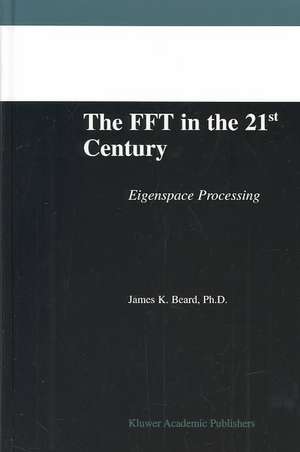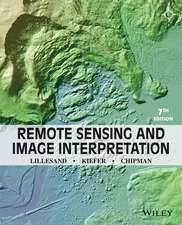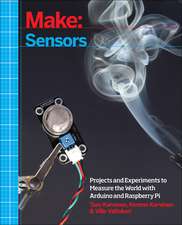The FFT in the 21st Century: Eigenspace Processing
Autor James K. Bearden Limba Engleză Hardback – 30 oct 2003
| Toate formatele și edițiile | Preț | Express |
|---|---|---|
| Paperback (1) | 637.46 lei 6-8 săpt. | |
| Springer Us – 6 dec 2010 | 637.46 lei 6-8 săpt. | |
| Hardback (1) | 643.84 lei 6-8 săpt. | |
| Springer Us – 30 oct 2003 | 643.84 lei 6-8 săpt. |
Preț: 643.84 lei
Preț vechi: 757.46 lei
-15% Nou
Puncte Express: 966
Preț estimativ în valută:
123.24€ • 133.91$ • 103.59£
123.24€ • 133.91$ • 103.59£
Carte tipărită la comandă
Livrare economică 22 aprilie-06 mai
Preluare comenzi: 021 569.72.76
Specificații
ISBN-13: 9781402076756
ISBN-10: 1402076754
Pagini: 236
Ilustrații: XV, 216 p.
Dimensiuni: 155 x 235 x 18 mm
Greutate: 0.51 kg
Ediția:2003
Editura: Springer Us
Colecția Springer
Locul publicării:New York, NY, United States
ISBN-10: 1402076754
Pagini: 236
Ilustrații: XV, 216 p.
Dimensiuni: 155 x 235 x 18 mm
Greutate: 0.51 kg
Ediția:2003
Editura: Springer Us
Colecția Springer
Locul publicării:New York, NY, United States
Public țintă
ResearchDescriere
This book was undertaken to provide a text and reference on the theory and practice of the FFT and its common usage. This book is organized in only four chapters, and is intended as a tutorial on the use of the FFf and its trade space. The trade space of the FFT is the parameters in its usage and the relationships between them - the sampie rate, the total number of points or the interval over which processing occurs in a single FFf, the selectivity of tuning to a given frequency over signals out-of-band, and the bandwidth over which a signal appears. The examples given in this text are in FORTRAN 9512003. FORTRAN 2003 was frozen as a standard while this work was in progress. The listings given here are intended as an aid in understanding the FFT and associated algorithms such as spectral window weightings, with the goal of making the best of them more accessible to the reader. The code I use here provides a simple bridge between the material in the text and implementation in FORTRAN 2003, C++, Java, MATLAB ©, and other modem languages. The examples are sufficiently simple to be translated into older languages such as C and FORTRAN 77 if desired.
Cuprins
Dedication. Author. Preface. Foreword. The Fourier Transform. 1: Overview. 2: Conventions and Notations. 2.1. Complex Variables and the Complex Conjugate. 2.2. Vectors and Matrices. 2.3. Matrix Transpose and Hermitian. 2.4. Common Functions. 3: The Fourier Transform. 3.1. The Classical Fourier Transform. 3.2. Our First Encounter with the Dirac Delta Function. 3.3. Meaning, Usefulness, and Limitations of Formal Identities. 3.4. The Inverse Fourier Transform. 3.5. Parseval's Theorem. 3.6. Multivariate Fourier Transforms. 3.7. Fourier Transform Pairs. 3.8. The Hilbert Transform. 4: The Classical Fourier Series. 4.1. The Fourier Series. 4.2. Parseval's Theorem. 5: The Discrete Fourier Transform. 5.1. The Transform - A Trigonometric Identity. 5.2. Parseval's Theorem. 5.3. The Dirichlet Kernel. 5.4. DFT Pairs. 6: Gibb's Phenomenon. 7: Spatial and Matrix Representations and Interpretations. 7.1. The Continuous Fourier Transform. 7.2. The Classical Fourier Series. 7.3. The Discrete Fourier Transform. 8: Problems. 8.1. General. 8.2. Classical Fourier Transform. 8.3. Classical Fourier Series. 8.4. Discrete Fourier Transform. 8.5. Greater Time and Difficulty. 8.6. Project. Introduction to the Radix 2 FFT. 1: Historical Note. 2: Notations and Conventions. 3: Ordering the Bits in the Addresses. 4: Examples. 4.1. Simple DIF and DIT. 4.2. Multivariate FFT. 5: Problems. 5.1. General. 5.2. Greater Difficulty. 5.3. Project. The Reordering Problem and its Solutions. 1: Introduction. 2: Different types of Cooley-Tukey FFTs. 3: In-place, self reordering FFTs. 4: Conclusions. 4.1. Summary. 4.2. Execution Speeds. 4.3. Variable Radix Algorithms. 4.4. Multivariate FFTs. 5: Examples. 6: Problems. 6.1. General. 6.2. Greater Difficulty. 6.3. Project. Spectral Window Weightings. 1: Overview. 1.1. Base Concepts - The DFT Trade Space. 1.2. Continuous and Discrete Spectral Windows. 1.3. Sampled Continuous Spectral Windows. 1.4. Noise Bandwidth. 1.5. Array Efficiency. 1.6. Spectral Window Frequency Response. 2: Discrete Spectral Windows. 2.1. The Dolph-Chebychev Window. 2.2. Chebychev 2 Window. 2.3. Split Chebychev 2 Window for Monopulse. 2.4. Finite Impulse Response Filters. 3: Continuous Spectral Windows and Sampled Continuous Windows. 3.1. Sampled Continuous Window Functions as Discrete Windows. 3.2. Cosine Windows. 3.3. Continuous Extensions of the Dolph-Chebychev Window. 4: Two-Dimensional Window Weightings. 4.1. Planar Radar Antennas and Two-Dimensional DFTs. 4.2. The Two-Dimensional Dolph-Chebychev Weighting. 4.3. Two-Dimensional Chebychev 2 Window. 4.4. Monopulse with Split Two-Dime












